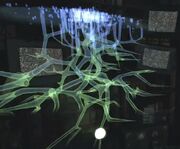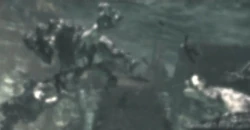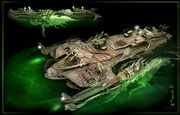- "The Hollow is a vast subterranean world beneath the surface of Sera, filling the surface with a maze of underground caverns and caves. Once considered the realm of mysterious and terrifying beasts, the Hollow has now been extensively explored."
- —Settlement 2's Natural History Museum Exhibit on the Hollow.

Adam Fenix's data on the Hollows.
The Hollow is an underground tunnel network beneath the surface of Sera that was home to indigenous, subterranean creatures as well as the Locust Horde. Located in the crust of Sera, the Hollow is separated between the Inner Hollow and Outer Hollow. The Outer Hollow is closer to the surface and was explored by humans after the invention of the Lightmass Process to refine Imulsion for fuel. The Inner Hollow lays deeper underground and appeared to be the cradle of the Locust civilization. The current fate of the Hollow is uncertain, after the Lightmass Offensive destroyed much of the Outer Hollow while the Inner Hollow was flooded when Jacinto City was sunk underground and filled with seawater.
Overview
The Hollow is the name for the underground network of tunnels that lay beneath the surface of Sera. It has been the Serans dumping grounds for hundreds of years.[1] The Hollow is the home of the Locust and was their home until they breached the surface of Sera on Emergence Day. Massive and complex, the Hollow and its tunnel network have yet to be completely mapped.
History
Prehistory
Aside from natural voids and caves in the planet's crust, the Hollow network in Sera was created by gargantuan creatures known as Riftworms. These 10-mile long creatures burrowed beneath the surface - constructing the large tunnel system seen in the Hollow. Because of the excrement left by the Riftworms, it allowed for life to be created in the Hollow. A large and complex eco-system was established in the Hollow. At some point, the Riftworms went extinct or dormant for years. Meanwhile, smaller creatures such Rockworms, Corpsers, and Seeders were responsible for further tunneling and creating the Hollow network.
Gold Rush
Humanity was aware of the existence of at least the Outer Hollow for a considerable length of time before Emergence Day, as they used it as dumping grounds. Several areas of the Outer Hollow were explored and mined for resources, such as petroleum or osmium. During the energy crisis on Sera, it was discovered that Imulsion, a low-viscous, naturally occurring liquid fungus could be refined into usable fuel through the Lightmass Process. After the creation of the Lightmass Process and the start of the Gold Rush, Serans began mining the Outer Hollows for Imulsion. During the Pendulum Wars, it was a restricted area.[2] However, it also triggered the Pendulum Wars, in which nations without natural Imulsion reserves, the Union of Independent Republics, lost economic and political power to nations that had majority of reserves, the Coalition of Ordered Governments, and fought for ownership of Imulsion.
During the Pendulum Wars, miners of Imulsion and their families began to contract a fatal disease known as Rustlung, caused by overexposure to Imulsion fumes. Fearing the economic and political ramifications of using a toxic fuel source, the Coalition transported the children of Imulsion-poisoned miners to the New Hope Research Facility, where they could be studied and treated. Under the supervision of geneticist Dr. Niles Samson, he attempted to not only treat the children but evolve humanity into superior beings by mutating them with the genetics of the indigenous creatures of the Hollow, resulting in mutated humans known as the Sires. Due to the unethical experimentation, employees leaked information about the facility, resulting in the Coalition shutting down the facility and indicting all involved. However, a Fringe COG Party built a secret lab in the Hollow under Mount Kadar where Niles Samson could transfer and continue his work.
Continuing his work underground, Niles Samson spliced the DNA of the Sires with the embryonic stem-cells of Myrrah, a child of an Imulsion miner born with an immunity to Rustlung. The splicing resulted in the birth of a new race of hybrids, the Locust Horde. Because Myrrah's stem-cells were used in the creation of the Locust, she was able to telepathically communicate and command them. She later gave birth to a human daughter named Reyna, but when the father escaped the facility with Reyna, Niles Samson lied to Myrrah that Reyna had died during the escape. Her grief and anger resulted in her commanding the Locust to break-out and rebel, massacring the human scientists and abandoning the facility. Myrrah, taking upon herself to become the Locust's Queen, led the Locust Horde to independence - taking them deeper into the Hollow to avoid human persecution and to start their own civilization.
Locust Occupation
Queen Myrrah led the Locust deeper into the Inner Hollow beneath Mount Kadar and began to construct their own civilization: Nexus. Using discarded materials and technology from human dumpsites in the Hollow, the Locust managed to construct the Royal Palace with surrounding cities, temples, and fortresses. They also managed to recycle materials to construct their own technology to build a society with its own language, religion, culture, military, and government. To build their army, the Locust began to capture and enslave natural creatures of the Hollow, genetically engineering them to act as weapons and transport. In 9 B.E., biologist, Doctor Elain Fenix, began to investigate the Inner Hollow following the discovery of mutated Rockshrews in 17 B.E. She then discovered the Locust Horde, but before she was able to reveal her findings to the public, she was executed by the Locust.
In 7 B.E., the effects of Rustlung returned to affect the Locust Horde. The exposure to Imulsion overtime led the Locust to become hosts for the Imulsion parasite, becoming Lambent. Aggressive and mutative, the Locust infected with Lambency were compelled to infect or kill those not infected. This resulted in the Lambent War, with the Locust Horde forced to fight their infected brethren. Because the Locust either suffered losses or became infected, the Locust quickly began to lose the war. Following her notes, physicist Professor Adam Fenix, husband of the late Elain Fenix, also discovered the Locust Horde. However, he was spared when Queen Myrrah believed he could help solve the Lambent crisis without harming the Locust. During this time, Adam Fenix spent extensive time in the Inner and Outer Hollow, plating Geobots to map the Hollow, and studying the effects of Imulsion.
However, Adam Fenix was unable to solve the Lambent crisis due being conscripted to build weapons of mass destruction for the Coalition of Ordered Governments Army and due to it being impossible to eradicate the Lambent without harming the Locust Horde and their ancestry linked to Imulsion-poisoned humans. Queen Myrrah then sought to invade the surface, eradicate the humans, and colonize Sera to abandon the Lambent. The Locust Horde then emerged on the surface on Emergence Day, waging a 17-year war against humanity known as the Locust War. Due to the Locust being underground, most of the Outer Hollow was abandon by Serans to avoid the enemy. The Locust continued to occupy and tunnel underneath the surface of Sera to emerge and slaughter all humans. The only place the Locust could not dig through, other than islands in the oceans of Sera, was the Jacinto Plateau. Consisting of granite bedrock, cities on the plateau such as Ephyra and Jacinto City were secure from the Locust.
For nearly ten years, the Locust attempted to attack the last safe cities by digging through natural fissures in the bedrock. In 10 A.E., the Locust were successful in emerging and occupying the Coalition capital city of Ephyra, forcing humanity to relocate to Jacinto City. Due to advice given by Adam Fenix, it was believed that by sinking Jacinto City, the surrounding seawater would flood the sinkhole and thus flood the entire Inner Hollow, killing all life below the surface. Queen Myrrah then set her sights on sinking cities on the Jacinto Plateau in order to weaken the bedrock and give the ability to sink Jacinto City. Meanwhile, the Coalition constructed the Sonic Resonator and the Lightmass Bomb in Gale, 14 A.E. In the Lightmass Offensive, the Coalition attempted to use the Sonic Resonator to map the Locust tunnels in the Outer Hollow and then use the Lightmass Bomb to destroy the heart of the Hollow. The Sonic Resonator failed to map the complete Outer Hollow, but the data-mapping provided by Adam Fenix's Geobots allowed the Coalition to properly destroy the Outer Hollow.

The Inner Hollows flooded.
The Lightmass Offensive successfully destroyed the Outer Hollow, but failed to destroy the Locust stronghold. Additionally, the Lightmass Bomb awoke a dormant Riftworm, allowing the Locust Horde the ability to sink entire cities and weaken Jacinto's base. The Riftworm was used to sink the cities of Tollen, Montevado, and Ilima on the Jacinto Plateau, allowing the Locust to advance and attempt to sink Jacinto City. In response, the Coalition began Operation: Hollow Storm, a campaign that sent a majority of Coalition troops to the Inner Hollow and personally destroy the Locust stronghold, but initially failed due to insufficient intel. Obtaining declassified intel from the New Hope Research Facility, the Coalition discovered that the Locust were located beneath Mount Kadar, allowing the Coalition to attack Nexus. When the Coalition found Adam Fenix's research, they decided to sink Jacinto for themselves before the Locust and Lambent could escape the Hollow. Using a Lambent Brumak, the Coalition was successful in sinking Jacinto City and flooding the Hollow. A majority of the Locust Horde and indigenous creatures of the Hollow were killed during the flooding.
Aftermath
In the aftermath of these events, it is unknown if any parts of the Hollow remain intact. Any Locust that survived fled the Hollow and turned to living on the surface as the Savage Locust while others became the Queen's Guard. The Imulsion from the Hollow was raised to the surface by the flood, resulting in the Lambent Pandemic. However, the Imulsion Countermeasure Weapon created by Adam Fenix eradicated all Imulsion and Lambent lifeforms, and neutralizing the Locust Horde for twenty-five years.
During this time, it is unknown about the current state of the Outer and Inner Hollow. However, some underground sites in the Outer Hollow remained intact, such as Osmium Mine Bravo. The Hollow and its creatures were a focus of study in Settlement 2's Natural History Museum.
Description
Outer Hollow
- "The surface of Sera is honeycombed with a dense network of caves, tunnels, aquatics and caverns."
- —Settlement 2's Natural History Museum Exhibit on the Outer Hollow.

The Outer Hollow.
The Outer Hollow is the outermost part of the Hollow near the surface. Barren of fauna and natural life other than Imulsion, it has been largely explored by human miners and had miles of piping and mining stations built across the subterranean landscape. It was a known fact that miners had shorter lifespans than the average human due to the hazards of Imulsion mining. This part of the Hollow was also the dumping ground of the human race. Ironically, because of this the Locust Horde discovered and developed many of their weapons which allowed them to attack the humans years later. Water flows in rivers throughout the Hollow, and every surface is constructed of rocky terrain. Stalactites and stalagmites are common, sometimes in such size to create full columns. The Outer Hollow was occupied by the Locust Horde shortly before Emergence Day, but was destroyed by the Lightmass Bomb during the Lightmass Offensive in Gale, 14 A.E.
Inner Hollows
- "Below the Outer Hollow, the cave systems join to form huge caverns, often flooded with enormous underground lakes."
- —Settlement 2's Natural History Museum Exhibit on the Inner Hollow.

The Inner Hollow.
The Inner Hollow is the deepest parts of the Hollow. Unlike the Outer Hollow, the Inner Hollow has natural flora and underground lakes, and was naturally inhabited by indigenous fauna and large Imulsion reserves. Human exploration hardly reached the Inner Hollow except for the scientists of the Mount Kadar Laboratory. Following a violet uprising, their experiments: the Locust Horde colonized the Inner Hollow and created a vast civilization, involving the creation of their capital, Nexus. However, the Inner Hollow began to become overrun with an epidemic of Lambency, in which the Imulsion was able to infect, control, and mutate hosts into infecting and killing other lifeforms. The Inner Hollow was invaded by the Coalition of Ordered Governments in Frost, 14 A.E., and was flooded entirely with seawater after the city of Jacinto was sunk underground by the Coalition to drown both the Locust Horde and Lambent lifeforms.
Indigenous Creatures
Creatures native to the Hollows include the Locust and the menagerie of creatures they use in their army. However, there are multiple other creatures that aren't part of the Locust Horde that also inhabit the Hollows. In the aftermath of the destruction of the Outer Hollows and the flooding of the Inner Hollows via Jacinto's sinking, the fate of many indigenous creatures is unclear. Creatures utilized by the Locust Horde escaped amongst the Savage Locust, whilst aquatic creatures such as the Mangler and Leviathan have been sighted in Sera's Oceans. Any creatures that could not escape the Hollow may have been wiped out, although it is not known.
Mangler

Manglers attached to a Locust Gunboat.
The Locust use these beasts to steer the Locust Gunboat. They appear to be native to the Inner Hollow, but since the sinking of Jacinto they have been sighted in Sera's oceans.
Rockworms
These semi-giant worms inhabit small caves within the Inner Hollows. They are protected from most hazards by their extremely resilient rock-like shell, which makes them impervious to all types of gunfire. The Locust appear to use them as a food source, as several butchered corpses are found in the Locust capital of Nexus.
Riftworms
At least three of these exist and are worshiped by the Locust as their gods as part of the Trinity of Worms. These creatures are giant worms that are 8-10 miles long and created the Hollows by moving around underground. Eventually they all entered hibernation, but one was awakened by the Lightmass Bomb and was used to sink three COG cities before it was killed by Delta-One during Operation: Hollow Storm.
Serapede
These gigantic centipedes originated in the Hollow but have been sighted on the surface after the Hollow's flooding by Jacinto's sinking. They are heavily armored and can attack using electricity in their jaws, their tail being the only weak spot. Utilized in the Locust Army, their fate after the destruction of the Horde is unknown.
Heart Leeches
Unlike other indigenous creatures, Humans were aware of their existence during the Pendulum Wars. This suggests they are native to the Outer Hollows, but they are known to have survived the Lightmass Bombing so it is possible they also live in the Inner Hollows. They are not part of the Locust Horde but they are known to attack humans due to their predatory nature.
Kryll
Kryll were highly aggressive flying pack creatures native to the Outer Hollow. They do not inhabit the Inner Hollows but after E-Day they began hunting on the surface of Sera. The species was obliterated by the Lightmass Bombing and they are now extinct.[3][4]
Hollows-Beetle
These tiny purple beetles crawl across the floor of the Inner Hollow in little groups. They are harmless and usually run away when anything comes too close. They can be killed by stepping on them or shooting them.
Hollows-Bat
These strange crane-like bats can be seen flying around the Inner Hollows. They can easily be confused with the Kryll, but they differ as they inhabit the brightly lit areas of the Inner Hollows and do not attack Locust or Gears that they encounter.
Hollows-Fly
These creatures are often seen flying around corpses in the Hollows, presumably feeding and laying their eggs. They're too large to be normal flies and they're also a grayish-purple color. The flies also seem to have four wings.
References
- ↑ http://gearsforums.epicgames.com/showpost.php?p=7826629&postcount=83--
- ↑ Gears of War: Anvil Gate
- ↑ The Lightmass Bombing destroyed their breeding grounds and left 99.9% of the population dead
- ↑ Gears of War: Hollow
